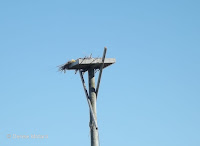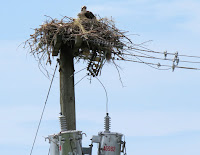OSPREY
OSPREY (Pandion haliaetus) – (See images below)
DESCRIPTION: The Osprey is a large bird of prey. The top parts are generally brown and the under parts white. There is a dark brown patch around the yellow eyes. The bill is black, the feet white but the talons are black. Sexes are similar, but females are slightly larger. The bird is around 60 cm (two feet) long.
VOICE: https://www.xeno-canto.org/species/Pandion-haliaetus
NAME: Author Ernest Choate (The Dictionary of American Bird Names) provides a long explanation for the complicated origin of the English name of this predator, which means ‘bone breaker’ (‘os’ = bone, and ‘frangere’ = to break). As for the Latin genus name ‘Pandion’, it comes from Greek mythology and refers to a species of hawk. The Latin species name ‘haliaetus’ is also from Greek and refers to an ‘osprey’ or ‘sea eagle’.
HABITAT: Any expanse of water with fish.
DIET: Almost exclusively made of fish. Ospreys dive feet first to catch fish near the water surface, and have oily feathers to maintain them waterproof.
NESTING: This bird builds a large nest on top of a high tree or will use human-built structures, such as the top of an electric pole. Because they use the same nest of branches year after year, the nest sometimes will collapse under its own weight, or from broken branches supporting it. To help with this potential problem, poles are installed with a platform to entice the osprey to use it as a nest.
The risk to ospreys when they nest on top of electric poles is electrocution, and for humans, power outages. Therefore some electric utilities will use their equipment to help move an osprey nest from an electric pole to a more suitable location.
DISTRIBUTION: The osprey range covers most of the world except Australia and New Zealand. Some individuals will visit Hawaii along coastal areas.
Distribution map: https://en.wikipedia.org/wiki/Osprey#/media/File:Wiki-Pandion_haliaetus.png
ON PEI: Although breeding on Prince Edward Island, the osprey usually does not stay for the winter, due to its source of food being covered with ice.
CONSERVATION: Osprey numbers appear stable overall, now that it is a protected species. They used to be hunted as many other birds of prey, and their eggs were harvested as well. The DDT pesticide was banned in the 1970s in part because it was softening the shells of birds of prey such as the osprey. Some current risks include garbage such as plastic rings for beverages in aluminium cans, which can smother the birds. It is recommended, when disposing of those rings, to cut them first to prevent this.
The nests below from different locations are made on a platform that sits on top of a pole, a structure easy to build and that meets the needs of the bird. Those nests show a human origin to some of the materials used by the osprey to build the nest, aside from the natural materials such as branches and twigs. One can see shreds of garbage bags, electrical wires, and part of Christmas lights on one nest, fish netting on another, and some strapping on another nest.There have been instances of osprey young tangled in garbage materials in their own nests.
NOTES: The osprey has the unique ability (with the owls) to reverse one of its front toes behind, giving it a better grip at their prey – slippery fish. Here’s an article showing an osprey carrying a shark carrying a fish. The osprey is the official bird of Nova Scotia.
OSPREY NEST ON ELECTRICAL POLE: There is a photo below showing an active osprey nest with a chick sitting on top of an electrical pole with 3 transformers. When I contacted the utility they said they had already 'de-energized' the wires there without cutting power to their customers. Once the nest is empty they said they will remove it and put back power on.
SIMILAR SPECIES: Bald Eagle, Red-tailed Hawk
REFERENCES: http://www.hww.ca/en/wildlife/birds/osprey.html
http://www.arkive.org/osprey/pandion-haliaetus/
https://www.mba-aom.ca/jsp/toc.jsp (Maritime Breeding Bird Atlas)
http://www.osprey-watch.org/learn-about-osprey/hazards-to-nesting-ospreys/
https://www.allaboutbirds.org/guide/Osprey/id
https://www.audubon.org/field-guide/bird/osprey
https://www.grandriver.ca/en/outdoor-recreation/Belwood-Lake-OspreyCam.aspx?_mid_=515
https://www.novascotiawebcams.com/en/webcams/ospreycam/
https://hawkwatch.org/learn/factsheets/item/372-osprey
This video below shows a juvenile osprey calling from its nest. Taken at Robinson’s Island, Prince Edward Island National Park:
Below is a video of an osprey that made its nest on top of an electrical pole with 3 transformers (see photo above). The utility company 'de-energized' them to protect the birds while they were raising their chicks. They will remove the nest once the fledglings are gone. Posts with platforms on top are provided for these birds to prevent those situations from happening, but ospreys still sometimes choose electrical poles. We can also see some hanging plastic garbage under the nest. The parent is eating some prey while calling. I noticed one chick in that nest (see last photo above).
DESCRIPTION: The Osprey is a large bird of prey. The top parts are generally brown and the under parts white. There is a dark brown patch around the yellow eyes. The bill is black, the feet white but the talons are black. Sexes are similar, but females are slightly larger. The bird is around 60 cm (two feet) long.
VOICE: https://www.xeno-canto.org/species/Pandion-haliaetus
NAME: Author Ernest Choate (The Dictionary of American Bird Names) provides a long explanation for the complicated origin of the English name of this predator, which means ‘bone breaker’ (‘os’ = bone, and ‘frangere’ = to break). As for the Latin genus name ‘Pandion’, it comes from Greek mythology and refers to a species of hawk. The Latin species name ‘haliaetus’ is also from Greek and refers to an ‘osprey’ or ‘sea eagle’.
HABITAT: Any expanse of water with fish.
DIET: Almost exclusively made of fish. Ospreys dive feet first to catch fish near the water surface, and have oily feathers to maintain them waterproof.
NESTING: This bird builds a large nest on top of a high tree or will use human-built structures, such as the top of an electric pole. Because they use the same nest of branches year after year, the nest sometimes will collapse under its own weight, or from broken branches supporting it. To help with this potential problem, poles are installed with a platform to entice the osprey to use it as a nest.
The risk to ospreys when they nest on top of electric poles is electrocution, and for humans, power outages. Therefore some electric utilities will use their equipment to help move an osprey nest from an electric pole to a more suitable location.
DISTRIBUTION: The osprey range covers most of the world except Australia and New Zealand. Some individuals will visit Hawaii along coastal areas.
Distribution map: https://en.wikipedia.org/wiki/Osprey#/media/File:Wiki-Pandion_haliaetus.png
ON PEI: Although breeding on Prince Edward Island, the osprey usually does not stay for the winter, due to its source of food being covered with ice.
CONSERVATION: Osprey numbers appear stable overall, now that it is a protected species. They used to be hunted as many other birds of prey, and their eggs were harvested as well. The DDT pesticide was banned in the 1970s in part because it was softening the shells of birds of prey such as the osprey. Some current risks include garbage such as plastic rings for beverages in aluminium cans, which can smother the birds. It is recommended, when disposing of those rings, to cut them first to prevent this.
The nests below from different locations are made on a platform that sits on top of a pole, a structure easy to build and that meets the needs of the bird. Those nests show a human origin to some of the materials used by the osprey to build the nest, aside from the natural materials such as branches and twigs. One can see shreds of garbage bags, electrical wires, and part of Christmas lights on one nest, fish netting on another, and some strapping on another nest.There have been instances of osprey young tangled in garbage materials in their own nests.
NOTES: The osprey has the unique ability (with the owls) to reverse one of its front toes behind, giving it a better grip at their prey – slippery fish. Here’s an article showing an osprey carrying a shark carrying a fish. The osprey is the official bird of Nova Scotia.
OSPREY NEST ON ELECTRICAL POLE: There is a photo below showing an active osprey nest with a chick sitting on top of an electrical pole with 3 transformers. When I contacted the utility they said they had already 'de-energized' the wires there without cutting power to their customers. Once the nest is empty they said they will remove it and put back power on.
SIMILAR SPECIES: Bald Eagle, Red-tailed Hawk
REFERENCES: http://www.hww.ca/en/wildlife/birds/osprey.html
http://www.arkive.org/osprey/pandion-haliaetus/
https://www.mba-aom.ca/jsp/toc.jsp (Maritime Breeding Bird Atlas)
http://www.osprey-watch.org/learn-about-osprey/hazards-to-nesting-ospreys/
https://www.allaboutbirds.org/guide/Osprey/id
https://www.audubon.org/field-guide/bird/osprey
https://www.grandriver.ca/en/outdoor-recreation/Belwood-Lake-OspreyCam.aspx?_mid_=515
https://www.novascotiawebcams.com/en/webcams/ospreycam/
https://hawkwatch.org/learn/factsheets/item/372-osprey
 |
| Osprey platform nest, PEI, Canada |
 |
| Osprey on nest with garbage pieces PEI, Canada, © Marie Smith |
 |
| Osprey nest with bird, for scale near Abu Dhabi City, by Sjahanmi |
 |
| Active Osprey nest on electrical pole, 'de-energized' to protect the birds |
 |
| Osprey on nest, PEI, by Matt Beardsley |
 |
| Osprey pair on their nest, Matt Beardsley |
 |
| Osprey catching fish, PEI, Matt Beardsley |
 |
| Osprey landing with fish, Matt Beardsley |
 |
| Osprey enjoying fish, by Matt Beardsley |
 |
| Osprey nest (the one on electrical pole above) with a young - Morell, PEI |
This video below shows a juvenile osprey calling from its nest. Taken at Robinson’s Island, Prince Edward Island National Park:
Below is a video of an osprey that made its nest on top of an electrical pole with 3 transformers (see photo above). The utility company 'de-energized' them to protect the birds while they were raising their chicks. They will remove the nest once the fledglings are gone. Posts with platforms on top are provided for these birds to prevent those situations from happening, but ospreys still sometimes choose electrical poles. We can also see some hanging plastic garbage under the nest. The parent is eating some prey while calling. I noticed one chick in that nest (see last photo above).